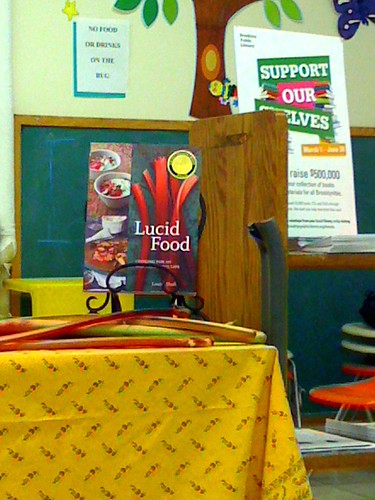Lucid Food at my local library
 One morning I was on Twitter when I saw Louisa Shafia mention an event she was doing that afternoon to help support the Brooklyn Public Library. Louisa is the author of Lucid Food, a phenomenal cookbook specializing in local foods and seasonal eating. The recipes are all accessible to cooks of any level. I had known about her cookbook for awhile, but I had never picked up a copy, having borrowed one from the library in an effort to curtail my cookbook buying addiction. After learning that we share a local library (the same one from A Tree Grows In Brooklyn!), and that she'd be doing a demo sharing her knowledge of cooking with farmer's market ingredients, I was in. Going to the library to talk vegetables was suddenly more exciting than I could have possibly imagined.
One morning I was on Twitter when I saw Louisa Shafia mention an event she was doing that afternoon to help support the Brooklyn Public Library. Louisa is the author of Lucid Food, a phenomenal cookbook specializing in local foods and seasonal eating. The recipes are all accessible to cooks of any level. I had known about her cookbook for awhile, but I had never picked up a copy, having borrowed one from the library in an effort to curtail my cookbook buying addiction. After learning that we share a local library (the same one from A Tree Grows In Brooklyn!), and that she'd be doing a demo sharing her knowledge of cooking with farmer's market ingredients, I was in. Going to the library to talk vegetables was suddenly more exciting than I could have possibly imagined.
 Louisa came armed with samples of all her favorite seasonal ingredients currently available at the greenmarket that we passed around, smelled, and tasted when possible. I realized there are a lot of leafy greens I have been skipping right over at the market. Hello sorrel, how have I been ignoring you all this time?! They sell locally grown Shiso leaves in Union Square? I guess I was going, but falling into the trap that she mentioned, just going straight for my favorite (safe) foods, without really seeing the bounty of what was available.
Louisa came armed with samples of all her favorite seasonal ingredients currently available at the greenmarket that we passed around, smelled, and tasted when possible. I realized there are a lot of leafy greens I have been skipping right over at the market. Hello sorrel, how have I been ignoring you all this time?! They sell locally grown Shiso leaves in Union Square? I guess I was going, but falling into the trap that she mentioned, just going straight for my favorite (safe) foods, without really seeing the bounty of what was available.
When faced with a new vegetable she said you can always ask the vendors for cooking suggestions. About 99% of the time, someone will suggest to saute it with butter or olive oil and garlic. And, truth be told, when doesn't that work? It reminded me that, I don't need a recipe in mind to buy something I've never cooked before. In fact, later that week, I (finally) had the courage to try cooking the radish greens that I had been shamefully discarding. As a child I was utterly disgusted by leafy greens, but I've been working hard to get over that fear even if I find it subconsciously influences my cooking from time to time. I'm pretty much cured at this point, happily eating spinach, all types of chard, kale and...now radish greens! Seriously, they were so much more flavorful than I expected. And, yes, I sauteed them in olive oil with garlic, onion, and lots of salt and pepper. Proof here.
Louisa gave so many wonderful tips about the ingredients in season right now that, I've listed the highlights for you at the bottom of the post. To really learn all she knows, I encourage you to pick up a copy of Lucid Food. As all my trips to the library end, I came out a bit smarter than I went in...and this time with an arm full of recipes to try. She encouraged all of us to force ourselves to explore at the market, and I've been heading her advice every week since.

Summer produce to try
Shiso Leaves - release the aroma by rubbing the leaves. Sometimes called Beefstake plant. Use to add a meaty flavor to dishes. Throw them in at the end of cooking, like an herb.
Garlic Scapes - they are the green end of the garlic head. Great pickled. (I like using them to make a pesto.)
New Young Garlic - sweeter than older garlic found in the supermarket. You can use the whole long stem like a leek. (I had no idea!)
Thai Basil - used in South Asian dishes, super fragrant. Combines well with mint. Try it in a stir-fry, or summer rolls.
Sorrel - used to be more popular. It's flavor is sour and lemon-y. Will add a lemon flavor to dishes, great with shrimp, and you can make soup out of it.
Rhubarb - little too late right now for this, but when you find it, use it in sweet (compotes or pies) or savory dishes, such as paired with a fatty meat. Don't eat the leaves, they are toxic. Contains lots of Vitamin C.
Baby Beets - sweeter and more tender than larger ones. Leaves are delicious too, if cooked like spinach. Try them in a salad, sliced thin. Lucidfood.com has a beet burger recipe.
Fava Beans - have to take seeds out of the pod, boil them for 10 minutes, then pull the membrane off. Grill them whole, or puree them like a hummus. (Note: these may be gone by now - check your market).
Sugar Snap Peas - great raw for a snack. Slice them thin for a salad.
Avocado Zucchini - it's a type of zucchini shaped more like an avocado. Contains less water content than the usual variety.





















